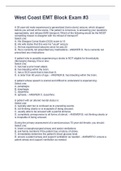Exam (elaborations)
West Coast EMT Block Exam #3
- Course
- Institution
A 30-year-old male experienced a generalized (tonic-clonic) seizure, which stopped before you arrived at the scene. The patient is conscious, is answering your questions appropriately, and refuses EMS transport. Which of the following would be the MOST compelling reason to disagree with his refusal...
[Show more]



